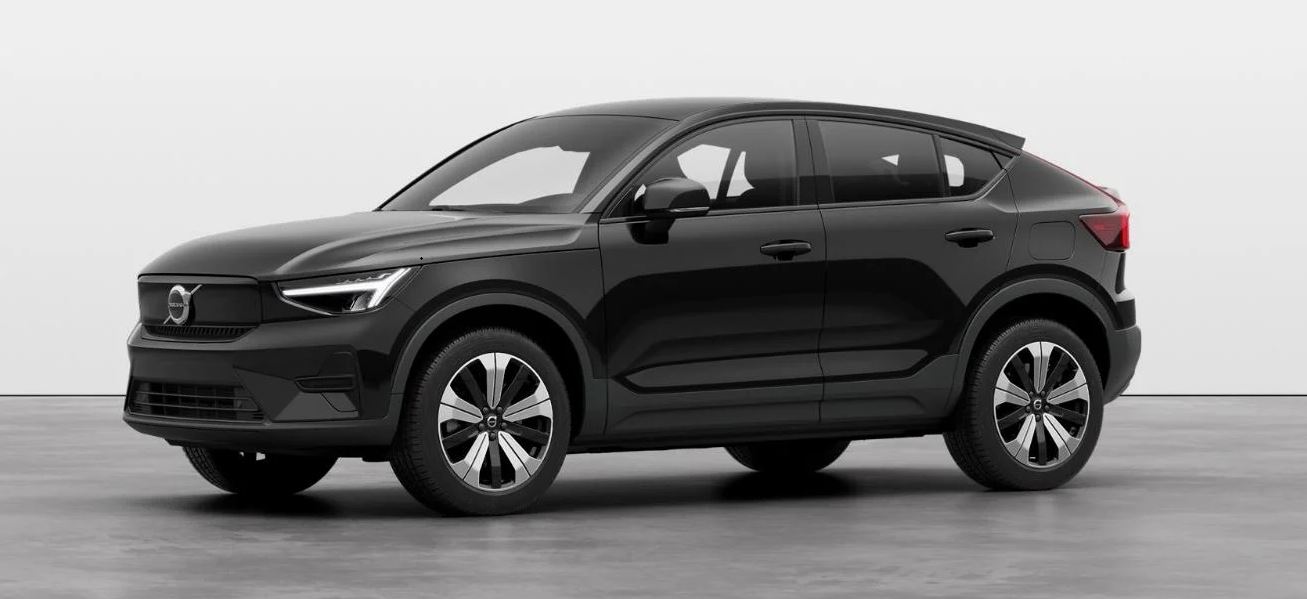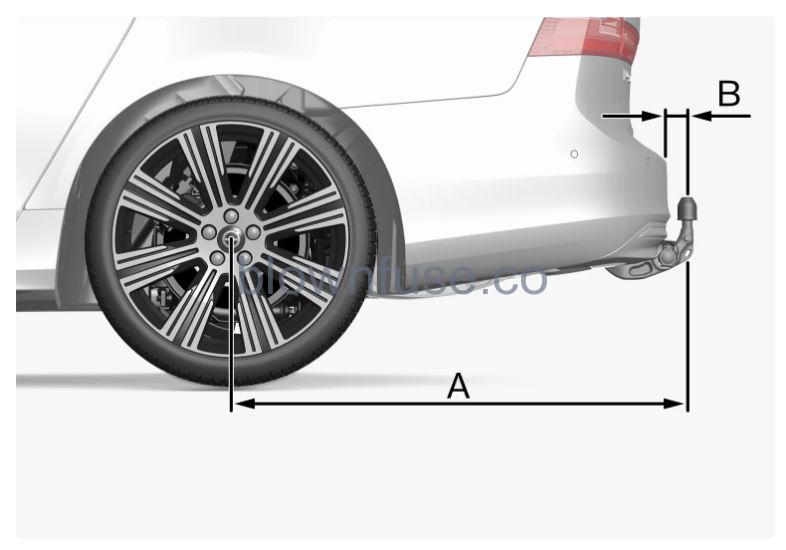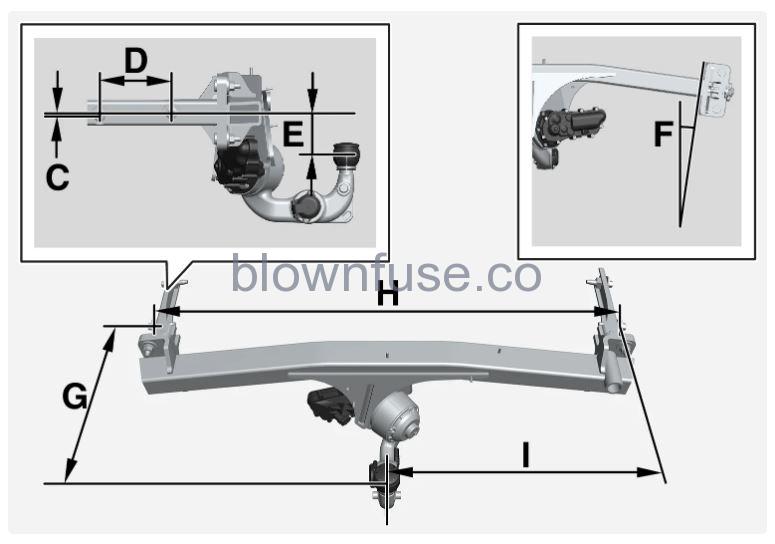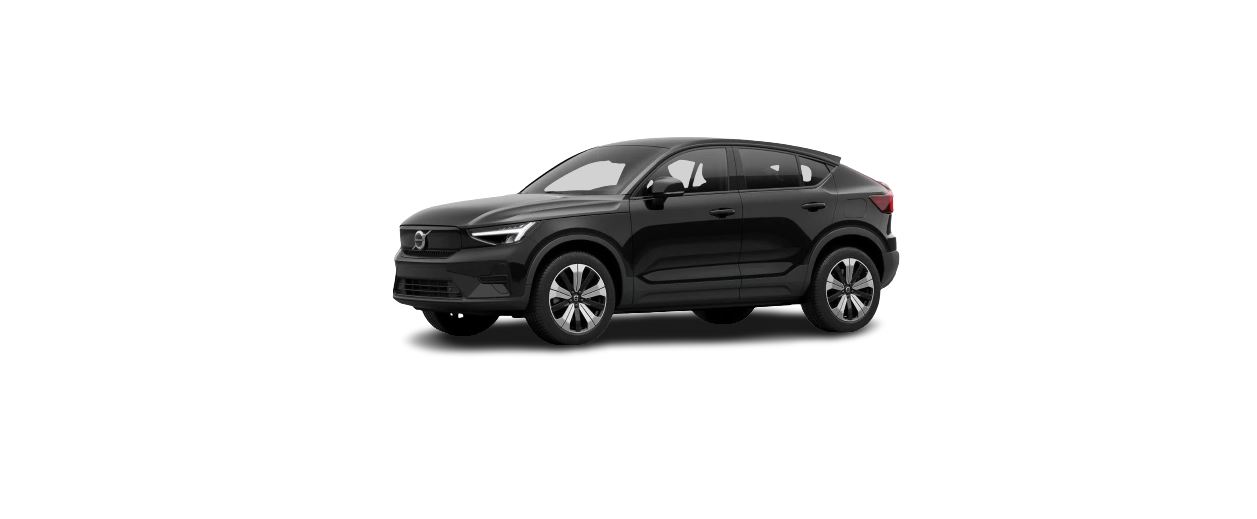2023 Volvo C40 Recharge Towbar and trailer

Towing capacity and towball load
Max. weight braked trailer
Note
Use of vibration dampers on the towbar is recommended for trailers heavier than 1800 kg.
| Braked trailer | Recharge Twin | Recharge |
| Max. weight (kg) | 1800 | 1500 |
| Max. towball load (kg) | 100 | 100 |
Important
When driving with a trailer, it is permitted to exceed the vehicle’s gross vehicle weight (including towball load) by a maximum of 100 kg (220 lbs), provided that speed is limited to 100 km/h (62 mph). National legal requirements for the vehicle combination, such as speed, etc. must be observed.
Note
If weight data is missing in the table, it will be updated at a later date.
Max. weight unbraked trailer
| Unbraked trailer | |
| Max. weight (kg) | 750 |
| Max. towball load (kg) | 50 |
Towbar(Option/accessory)
- The car can be equipped with a towbar that makes it possible to tow e.g. a trailer behind the car.
- There may be different towbar variants available for the car. Contact a Volvo dealer for more information.
Important
When the car is switched off, the constant battery voltage to the trailer connector can be switched off automatically in order not to drain the starter battery.
Important
The towball needs regular cleaning and lubrication with grease in order to prevent wear.
Note
- When a hitch with a vibration damper is used, the tow ball must not be lubricated.
- This also applies when fitting a bicycle rack that is clamped in around the tow ball.
Specifications for towbar(Option/accessory)

The illustration is generic and may vary depending on the model.

| Dimensions, mounting points in mm (inches) | |
|---|---|
| A | 939 (37) |
| B | 72 (2.8) |
| C | 6 (0.24) |
| D | 145 (5.7) |
| E | 88 (3.5) |
| F | Side beam tilts 8 degrees |
| G | 353 (13.9) |
| H | 1048 (41.3) |
| I | 524 (20.6) |
Towbar-mounted bicycle rack(Option/accessory)
This is in order to avoid damage to the car and in order to achieve the maximum possible safety during a journey. Volvo’s bicycle racks are available for purchase at authorised Volvo dealers.
Carefully follow the instructions enclosed with the bicycle rack.
- The bicycle rack including load must weigh a maximum of 75 kg (165 pounds).
- Rear Auto Brake should be deactivated before driving with a bicycle rack.
The bicycle rack can loosen from the towbar if it
- is incorrectly fitted on the towball
- is overloaded, see the bicycle rack’s instructions for maximum load weight
- is used for carrying something other than bicycles.
The car’s driving characteristics are affected when a bicycle rack is fitted on the towbar. For example due to:
- increased weight
- reduced acceleration capacity
- reduced ground clearance
- changed braking capacity.
Recommendations for loading bicycles on the bicycle rack
The larger the distance between the load’s centre of gravity and the towball, the greater the load on the towbar.
Load according to the following recommendations:
- Fit the heaviest bicycle furthest in, closest to the car.
- Keep the load symmetrical and as close to the centre of the car as possible e.g. by loading the bicycles facing alternately if several bicycles are loaded.
- Remove loose objects from the bicycle for transportation, e.g. bicycle basket, battery, child seat. Partly to reduce the load on the towbar and bicycle rack, and partly to reduce the wind resistance, which affects range.
- Do not use protective covers on the bicycles. This may affect manoeuvrability, impair visibility and increase energy consumption. It may also lead to an increased load on the towbar.
Extendable and retractable towbar(Option/accessory)
Warning
Follow the instructions for retracting and extending the towbar carefully.
Warning
- Do not press the extend/retract button if a trailer or accessory is attached to the tow bar.
 A button for extending/retracting the towbar is located on the right-hand side at the rear of the cargo area. The indicator lamp in the button flashes or illuminates with a constant orange glow when retracting and extending are active.
A button for extending/retracting the towbar is located on the right-hand side at the rear of the cargo area. The indicator lamp in the button flashes or illuminates with a constant orange glow when retracting and extending are active.
Extending the towbar
- Press and release the button in the cargo area – extending might not start if the button is pressed for too long.
- The towbar is extended outward and downward in an unlocked position – the indicator lamp flashes orange.
- Manoeuvre the towbar to its end position where it is secured and locked in.
- The indicator lamp illuminates with a constant glow when the towbar is ready for use.
Warning
Avoid standing close to the bumper in the centre behind the car when extending the towing hitch.
Important
- When the tow bar is activated by pressing a key and has been placed in the unlocked position:
- Wait at least 2 seconds before the tow bar is moved to the locked position. If the tow bar does not remain in the locked position, wait another few seconds and try again.
- Do not kick the tow bar.
WarningTake care to secure the trailer’s safety cable in the intended bracket.
Note
- Power save mode activates after a while and the indicator lamp goes out. The system is reactivated by closing and opening the tailgate. This applies when retracting or extending the towbar.
- If the car detects a connected trailer electrically, the indicator lamp stops illuminating with a constant glow. Towbar retraction and extension are then not possible.
Retracting the towbar
- Press and release the button in the cargo area – retracting might not start if the button is pressed for too long.
- The towbar is extended downward in an unlocked position – the indicator lamp flashes orange.
- Lock the towbar by moving it back to its retracted position, where it is locked.
- The indicator lamp will illuminate with a constant glow when the towbar is correctly retracted.
Important
Make sure that there is no plug or adapter in the electrical socket when retracting the towbar.
Important
- When the tow bar is activated by pressing a key and has been placed in the unlocked position:
- Wait at least 2 seconds before the tow bar is moved to the locked position. If the tow bar does not remain in the locked position, wait another few seconds and try again.
- Do not kick the tow bar.
Important
The towbar must always be retracted when not in use.
Driving with a trailer
Payload depends on the car’s kerb weight. The total of weight of the passengers and all accessories, e.g. towbar, reduces the car’s payload by a corresponding weight.
The car is supplied with the necessary equipment for towing a trailer.
- The car’s towbar must be of an approved type.
- Distribute the load on the trailer so that the weight on the towbar complies with the specified maximum tow ball load. Towball load is calculated as part of the car’s payload.
- Increase the tyre pressure to the recommended pressure for a full load.
- The electric motor is loaded more heavily than usual when driving with a trailer.
- Do not tow a heavy trailer when the car is brand new. Wait until it has been driven at least 1000 km (620 miles).
- Follow the regulations in force for the permitted speeds and weights.
- Maintain a low speed when driving with a trailer up long, steep ascents.
- Avoid driving with a trailer on inclines of more than 12%.
- Rear Auto Brake should be deactivated before driving with a trailer.
Trailer weights
Warning
Follow the stated recommendations for trailer weights. Otherwise, the car and trailer may be difficult to control in the event of sudden movement and braking.
Note
The stated maximum permitted trailer weights are those permitted by Volvo. National vehicle regulations can further limit trailer weights and speeds. Towbars can be certified for higher towing weights than the car can actually tow.
When driving in hilly terrain
Under certain circumstances, there may be a risk of overheating when towing a trailer. If the electric motor and drive system overheat, a warning symbol comes on in the driver display and a message is displayed.
Parking on a hill
- Depress the brake pedal.
- Activate the parking brake.
- Release the brake pedal.
- Block the wheels with chocks when parking a car with hitched trailer on a hill.
Starting on a hill
- Depress the brake pedal.
- Select gear position D or R and accelerate.
- The parking brake releases and the symbol in the driver display extinguishes. The car can now be driven.
Trailer stability assist(Option/accessory)
Reasons for snaking
The snaking phenomenon can occur with any car/trailer combination. Snaking normally occurs at high speeds. However, there is a risk of it occurring at lower speeds if the trailer is overloaded or the load is improperly distributed, e.g. too far back.
Triggering factors for snaking may, for example, include:
- Car with trailer subjected to sudden and powerful side wind.
- A car with a trailer drives on an uneven road surface or in a pothole.
- Sweeping steering wheel movements.
If snaking has started, it could be difficult or even impossible to suppress. This makes the car/trailer combination difficult to control and there is a risk that you could end up in the wrong lane or leave the carriageway.
Trailer stability assists function
The trailer stability assist function continually monitors the car’s movements, particularly lateral movements. If snaking is detected, the front wheels are individually braked. This serves to stabilise the car/trailer combination. This is often enough to help the driver regain control of the car.
If snaking is not eliminated the first time that trailer stability assist intervenes, the car/trailer combination is braked with all wheels and the car’s traction is reduced. Once snaking has been gradually suppressed and the car/trailer combination is stable once again, the system stops regulating and the driver once again has full control of the car.
Trailer stability assist may fail to intervene if the driver uses severe steering wheel movements to try to rectify the snaking because in such a situation the system cannot determine whether it is the trailer or the driver causing the snaking.
 When Trailer Stability Assist (TSA) is operating, the ESC symbol flashes in the driver display.
When Trailer Stability Assist (TSA) is operating, the ESC symbol flashes in the driver display.
Note
Retrofitting a towbar requires an update of the car’s software, contact a Volvo dealer.
Checking trailer lamps(Option/accessory)
Checking trailer lamps(Option/accessory)
Automatic checking
- After a trailer is connected electrically, it is possible to ensure that the trailer lamps are working via an automatic lamp activation. The function helps the driver check that the trailer lamps are working before starting off.
- When a trailer is connected to the towbar, Perform a trailer lamp check? the message is shown in the driver display.
- Confirm the message by pressing the right-hand steering wheel keypad’s O button.
- The lamp check starts.
- Exit the car to check lamp functionality.
- All trailer lamps start to flash – then the lamps are switched on one at a time.
- Visually check that all lamps available on the trailer are operational.
- After a moment, all lamps on the trailer flash again.
- The check is complete.
Rear fog lamp on the trailer
When connecting a trailer, there may be instances when the rear fog lamp on the car does not illuminate. In theses cases, rear fog lamp functionality is transferred to only the trailer. Therefore, in these cases, check when the rear fog lamp is activated that the trailer is equipped with rear fog lamp in order to drive the vehicle combination in a safe manner.
Symbols and messages in the driver display
If one or more of the trailer’s direction indicators or brake light bulbs is broken, the driver display shows a symbol and a message. Other lights on the trailer must be checked manually by the driver before setting off.
| Symbol | Message |
|---|---|
 |
Right trailer turn indicator malfunction
Left trailer turn indicator malfunction |
 |
Trailer brake light malfunction |
If any lamp for the trailer’s direction indicators is broken, the driver display symbol for direction indicators will also flash more quickly than normal.

